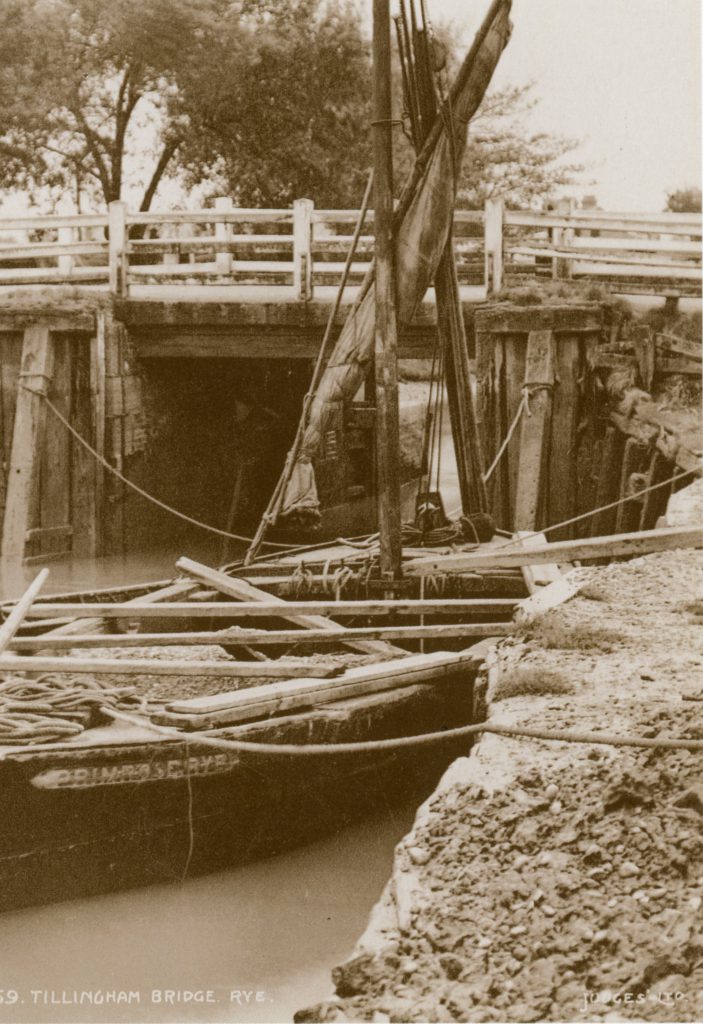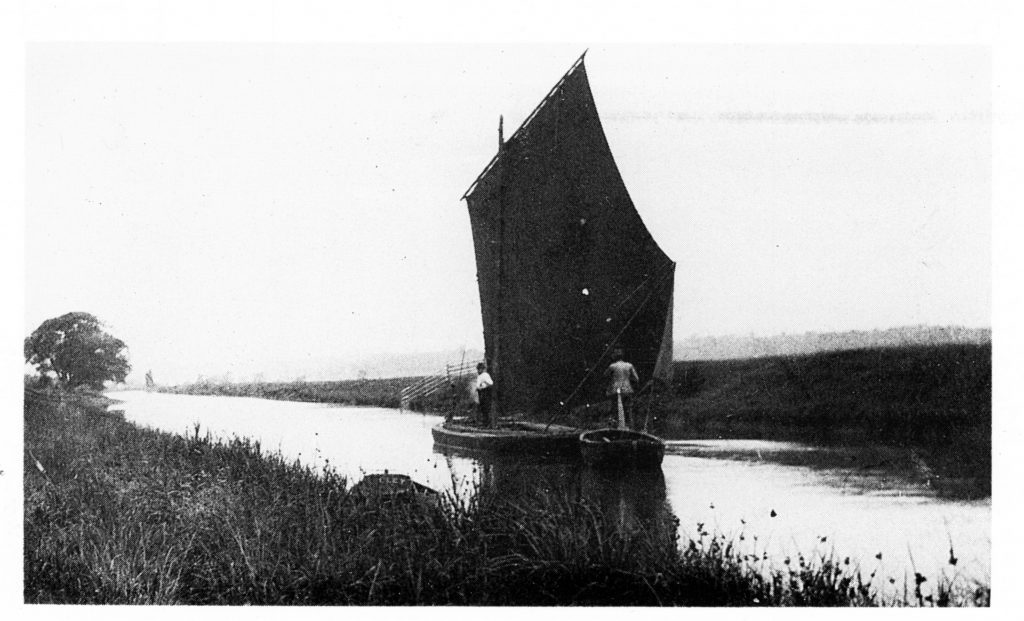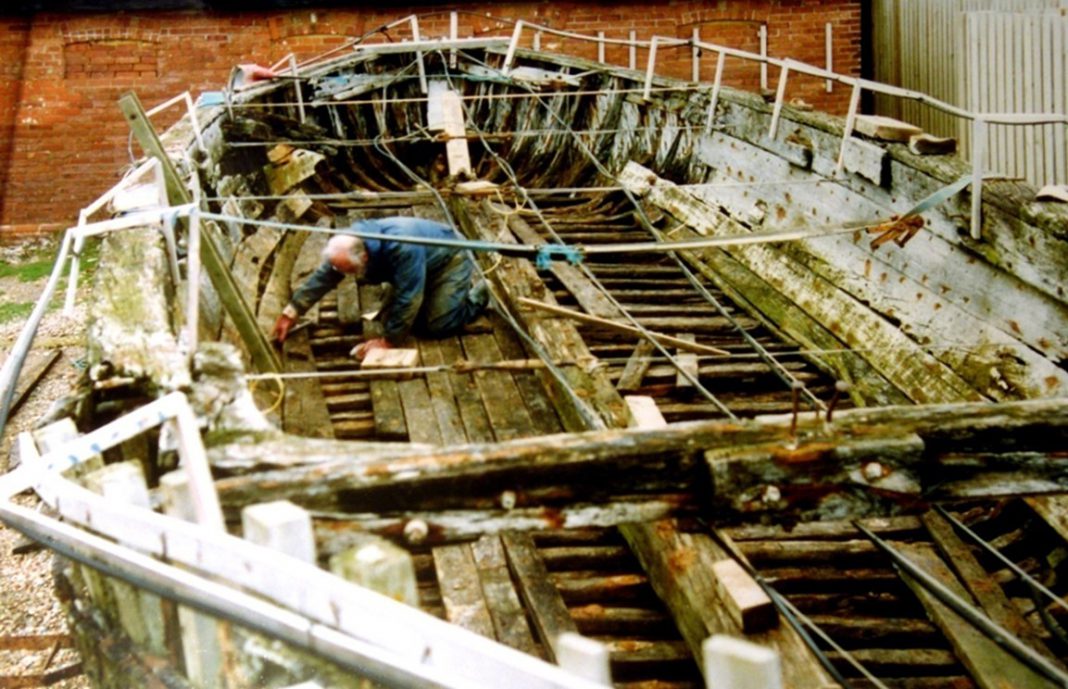Will Rye save the Primrose? A strange question, you might think – especially if you don’t know what the Primrose is. But read on and I will fill in the back story, a story which goes back about 130 years.
Primrose is the last of the Rye barges and she was built around 1890, in Rye, very close to the Strand Quay.
The Rye river barges were small everyday working craft providing a vital link between the port of Rye and the hinterland of the rivers Rother, Tillingham, Brede and, indeed, the Royal Military Canal to Folkestone.

In the late 19th century one company, Vidler & Son, became particularly associated with the fleet which also worked as lighters in the harbour discharging cargoes from the larger ships and working them up the shallower rivers and the military canal.
They were particularly used for shifting heavy bulk cargoes of the type that elsewhere in England were conveyed by narrow boats. Principal cargoes were timber, coal, hops, hop poles, manure, sand and ballast, though Primrose is also known to have carried bricks, wool, furniture, glass and livestock.
The continuity of the tradition of this type of vessel can be traced back to early 16th century and possibly even earlier. The distinctive shape of these barges is clearly shown in ancient maps of Rye harbour.
Over the years the barge trade suffered various ups and downs, some caused by the changing nature of the waterways themselves, some caused by general economic factors. Also, the dispersed nature of the rural communities they served meant that the trade was never intensive. Then, gradually over time first the railways then road vehicles took over as the preferred means of transporting such cargoes and the barges declined. We believe that the Primrose was last fully active in the 1930s.
Eventually she was abandoned in the mud on the saltings at Rye Harbour and for at least 50 years she was submerged by strong tides twice a day. A combination of this, and the wash from passing shipping, filled the interior of Primrose with mud, thus inadvertently helping preserve her. People’s memories of the old barges persisted, too, and around 1990 a local resident pointed her out to the Nautical Archaeology Society (NAS) which courageously decided to save her because it was thought unlikely she would survive another winter.

So it was that in April 1990 the remains of no fewer than three barges were brought to the attention of the project officer of the NAS, Valerie Fenwick. Valerie, together with the Nautical Museums Trust (NMT) which operates Hastings’ Shipwreck Museum, formulated and executed a plan to rescue the most complete of those barges, the Primrose, and move her to a new extension at the Shipwreck Museum at Rock a Nore, Hastings.
Preparations for the operation took almost two years. First, a team of volunteers had to dig out the mud from inside and around Primrose and wrap the barge in plastic to make her waterproof. Then Primrose was floated and towed to Rye Harbour where a crane lifted her onto a lorry. Easy to say but much organisation and some persuasion were needed to arrange things such as the crane, the low loader, decide the route and assemble volunteers. But eventually all was ready.
On Sunday, 3 October 1992, therefore, Primrose made her final journey by low loader with police escort to the Museum. And that is where she has been for the past 27 years.
Primrose now rests in the backyard of the Shipwreck Museum, where wire hawsers are in place to pull together her bulging sides. It is possible for visitors to see Primrose there but in far from optimum conditions. She deserves further conservation, protection and display in a better setting where it would be possible to walk around her, admire her and learn about her history. Ideally that setting would be where she was built and spent her working life – Rye.
At the Shipwreck Museum a team of volunteers began work to restore her in the mid-1990s, but the effort could not be sustained and she had to be left to herself for many years. Although the NMT would dearly like to be able to restore the Primrose, we are a charity with inadequate resources to achieve this. We also believe that Rye, not Hastings, is where she should reside.
So for now she is in a state of suspended animation and ideally a project needs to be devised and funding secured to do more by way of preservation, restoration and interpretation so that the wider public can become aware of this small but important part of the local maritime heritage.
Primrose’s stay at the Shipwreck Museum was always intended to be only temporary. I hope by writing this article it will be possible to discover whether there is any way that a project can be initiated to return her to Rye, get preservation back on track and put her on display for the public to appreciate. Maybe there is an opportunity somewhere in or near the proposed developments at Bridgepoint to find a suitable location? But if not there, where?
Surely Primrose – a part of Rye’s nautical heritage – needs to be back in Rye. What does Rye think?
Image Credits: Nautical Museum Trust .




Interesting. The Neighbourhood Planners considered this barge in its deliberations about heritage matters. We included the matter on P83 of the Plan (agreed in July). There are also historical pieces about the barges in Ryes Own. We had envisaged a project to reclaim the barge from Hastings and build a housing perhaps with a toughened glass roof so that visitors could view from above. The problem is identifying a suitable site. Some possibilities have been negated by recent development proposals. The barge is rather large and would need space! Having an aspiration in the Plan to cover such a project could provide the hook for a project team to tackle the issue! Perhaps once the future of the Rye Town Model and Heritage Centre has been solved, this could be next to be tackled!
Vice Chair Rye Neighborhood Plan Steering Group
Dear Anthony,
Thank you for the interest shown. Not living in Rye myself, I was unaware that the Primrose had been included in the Rye Neighbourhood Plan. So perhaps she is not as forgotten as I feared.
The Nautical Museums Trust would be happy to participate in discussions with the Town Council or any other interested group in trying to devise a way forward to restore and display Primrose in Rye.
She is listed in the National Historical Ships Register (and is thus the maritime equivalent of a listed building) and so is a significant part of our national heritage.
If suitable premises and support can be found perhaps she could become an attraction alongside the Rye Town Model and an extended Heritage Centre.
Best regards.
Haydon Luke